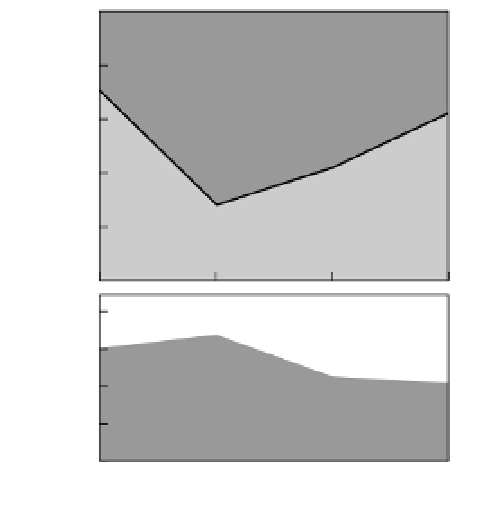Environmental Engineering Reference
In-Depth Information
These silvicultural strategies are the order of the day
within forest administration. Besides the ecological
aspects (Cannel
et al.
1992, Kelty
et al.
1992), mixed
stands are widely believed to be potentially more pro-
ductive than monospecific stands (Bartelink 1999),
which may be due to
complementarity
(tree species
may differ in their crown morphology, shade toler-
ance, in height and diameter dynamics, rooting depth
and/or phenology) and/or to
facilitation
(positive
interactions and feedbacks such as synergism and sym-
biosis). An improvement will also affect future wood
markets, economic results of forestry and different other
goods and services that forest ecosystems provide for
society.
Despite experience of how to technically convert pure
pine stands into mixed stands with broad-leaved
trees and of how one can increase structural elements,
knowledge about the ecological properties of these
mixed stands, for example the ecological interactions
between the tree species and their impact on the soil,
is generally vague. In this context the soil organic mat-
ter in the forest floor and the mineral soil are of par-
ticular interest (
V
on Zezschwitz 1985,
V
an Mechelen
et al.
1997, Puhe & Ulrich 2000). The humus form with
its morphological and chemical properties can be
viewed as an integrating indicator for assessing the
state of soil development in converted forest eco-
systems (H. Fischer
et al.
2002). Due to a decoupling
of the carbon cycle in space and time large litter
layers may develop in
P. sylvestris
and
P. abies
forests since in these forests the decomposition of plant
litter material is limited because of low mineraliza-
tion or bioturbation intensity. Often the result is typ-
ical humus disintegration. In connection with forest
conversion the humus form undergoes diagnostic,
morphological and chemical changes which are in turn
relevant for nutrient cycling and carbon sequestration.
The development of humus cover properties in the
course of conversion from pine to mixed stands of pine
and beech has been studied by comparing four forest
stands representing a chronosequence in the north-
east German lowland (Buczko
et al.
2002, H. Fischer
et al.
2002). The thickness of the dominating humus
form, mor, decreased within the chronosequence and
simultaneously a change was noted from moder-like
humus forms towards mull-like moder and oligomull.
The soil organic matter content in the humification
layer (H horizon) decreased due to bioturbate processes
100
HUMUS COVER
80
60
40
20
MINERAL SOIL
(0-100 cm)
0
400
300
200
100
0
Pine 84 years
Pine 76 years
Beech 34 years
Pine 114 years
Beech 57 years
Beech 91 years
Fig. 10.5
Accumulated humus stock and relative
distribution of soil organic matter in forest floor and
mineral topsoil (to 100 cm) in a chronosequence
of four study sites in north-eastern Germany. See
H. Fischer
et al.
(2002).
with an increasing percentage of beech. With respect
to the soil carbon stock and its distribution, two
developments can be stressed. In the initial phase of
forest conversion the total humus stock increased in
the younger mixed stand whereas in later stages the
soil organic reserves were decreasing continuously
(Fig. 10.5). In contrast to the pure stands of pine
and beech (initial and final phases of the chrono-
sequence) the mixed stands are characterized by a
significant decoupling of the carbon cycle whereas the
litter layer acts as the main storage compartment for
carbon. In beech forest the humus integration is relat-
ively good and organic matter is not stored mainly
in the humus cover and the upper Ae horizon (the
horizon in the upper soil layer showing evidence of
eluviation; as in Scots pine and mixed stands) but
mainly in deeper mineral soil. These horizons are intens-
ively penetrated by roots. The easier the prevailing
litter can be decomposed the faster humus integration
occurs.
Further studies will have to verify to what extent
the results of this forest conversion study can be





